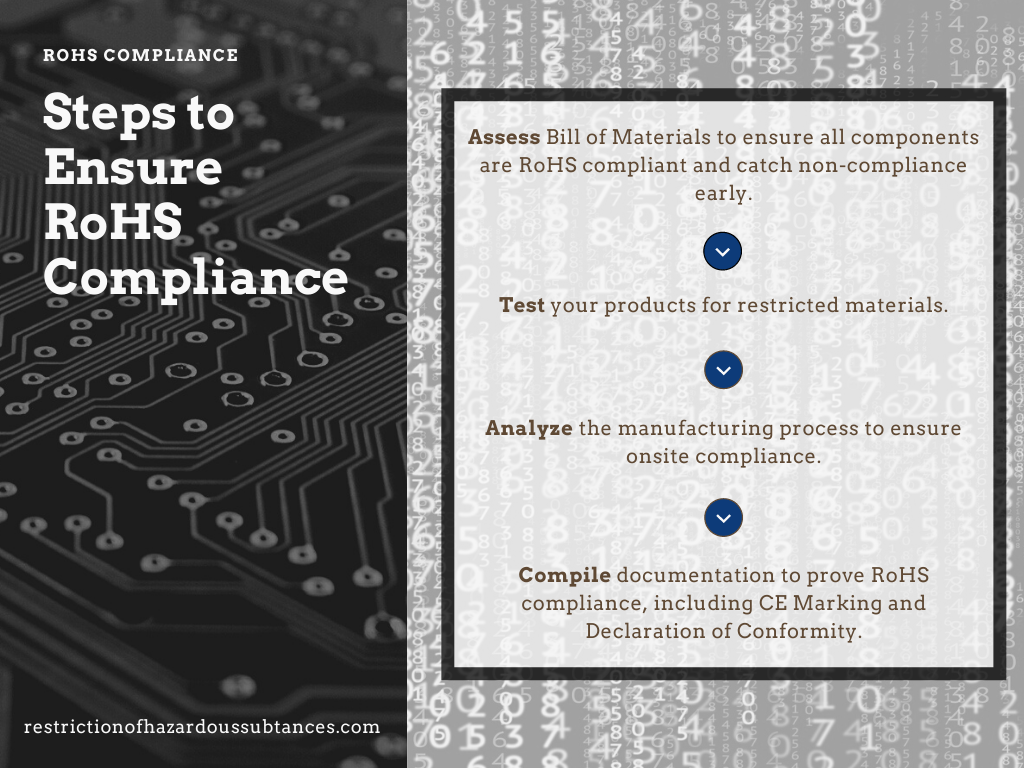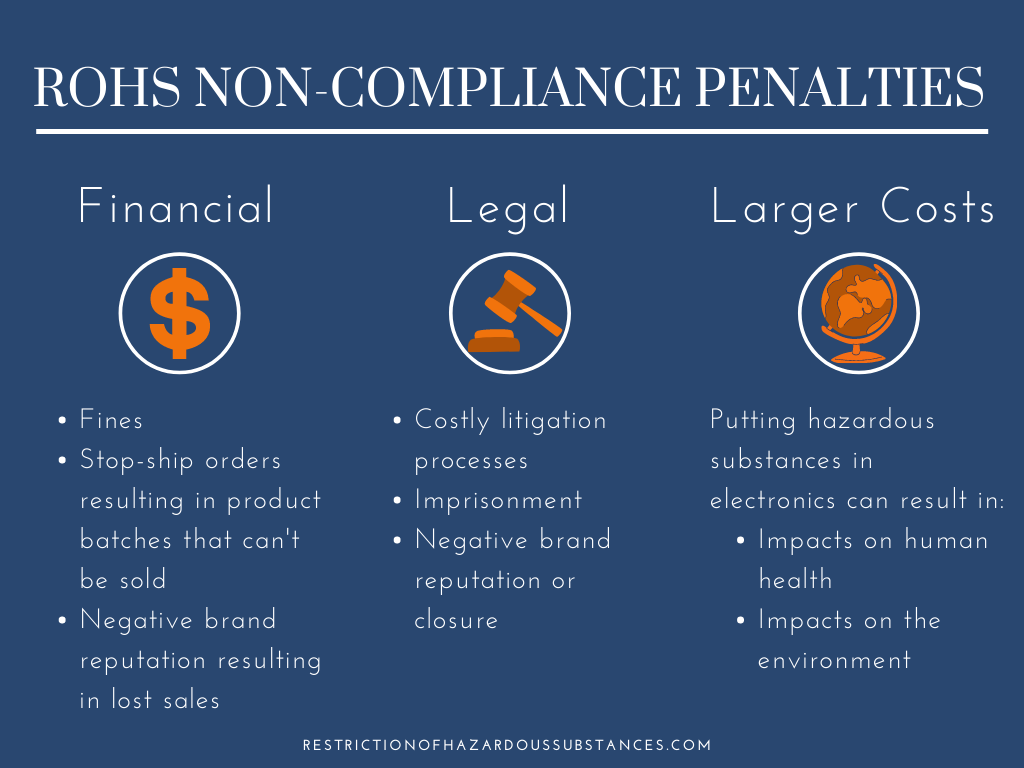Table of Contents
- What Is RoHS Compliant?
- Who Has to Ensure RoHS Compliance?
- Steps to Ensure A Product is RoHS Compliant
- Exemptions
- RoHS Non-Compliance Penalties
What Is RoHS Compliant?
The RoHS directive, issued in the European Union, restricts the use of ten hazardous materials in electronic and electrical equipment (EEE). A product is RoHS compliant if it does not exceed the allowable amounts of these restricted substances. All EEE sold in the EU must be RoHS compliant.
Restricted Substances
To be RoHS compliant, EEE must not contain any of the following hazardous substances in amounts larger than 1000 ppm. These materials are deemed to be hazardous to human health and the environment.
- Cadmium (Cd) [The allowable amount for cadmium is 100 ppm.]
- Mercury (Hg)
- Lead (Pb)
- Hexavalent Chromium (Cr VI)
- Polybrominated Biphenyls (PBB)
- Polybrominated Diphenyl Ethers (PBDE)
- Bis(2-Ethylhexyl) phthalate (DEHP)
- Benzyl butyl phthalate (BBP)
- Dibutyl phthalate (DBP)
- Diisobutyl phthalate (DIBP)
The current restrictions are the result of one original directive and two updates known as RoHS 2 and 3.
RoHS 1 – The original directive, Directive 2002/95/EC, was issued in 2002, and included six materials deemed to be hazardous to human health and the environment.
RoHS 2 – In 2011, the original directive was superseded by Directive 2011/65/EU, known as RoHS 2. RoHS 2 includes additional categories of appliances subject to RoHS, as well as a larger list of exemptions. RoHS 2 also includes additional steps businesses must take to achieve and demonstrate compliance.
RoHS 3 – The directive was amended in 2015 when Directive EU 2015/863, or RoHS 3, added 4 new restricted phthalates. RoHS 3 is simply an amendment to its predecessor, and businesses must still comply with all requirements of RoHS 2.
Read more: The Difference Between RoHS 1, 2 and 3
Rules similar to RoHS have spread to other regions, including India, China, South Korea, Vietnam, Japan, and U.S. states California and New Jersey. It is important for electronic companies to remain aware of shifting hazardous substance legislation in markets around the world so they can keep their products compliant and avoid RoHS non-compliance penalties.
Products Restricted by RoHS
Any manufacturer, importer, or distributor of electronic and electrical equipment (EEE) sold in the EU market must be compliant with RoHS.
EEE regulated under RoHS includes a wide variety of products separated into eleven categories, ranging from large household appliances to medical devices. The eleventh category is all-encompassing, as it includes any EEE not covered in the previous ten categories.
It is important that manufacturers determine whether their product fits the definition of EEE, because all EEE is subject to RoHS compliance requirements. RoHS defines EEE as: “equipment which is dependent on electric currents or electromagnetic fields in order to work properly and equipment for the generation, transfer and measurement of such currents and fields” (Directive 2011/65/EU).
Even small components of EEE, such as cables or other sub-assemblies, must comply with RoHS standards.

Who Has to Ensure RoHS Compliance?
Manufacturers are responsible for ensuring their product is RoHS compliant. Each product, rather than the company as a whole, must fulfill RoHS compliance requirements.
While the directive applies to all manufacturers, importers, or distributors of electronic and electrical equipment (EEE) sold in the EU market, it is the manufacturer who will be fined or penalized for non-compliance. It is up to manufacturers to remain aware of changing RoHS requirements.
Compliance can be expensive, as RoHS often requires manufacturers to use new or alternative processes that avoid the hazardous substances. Ensuring RoHS compliance can also add time to the production process of EEE. RoHS compliance may also increase EEE prices for consumers.
The costs associated with RoHS compliance, however, come hand in hand with safer, more environmentally friendly devices.
Read more about costs and benefits of RoHS: What is RoHS?
Steps to Ensure A Product is RoHS Compliant
All steps to ensure RoHS compliance must be completed before an EEE product can be put on the market. The steps included in RoHS compliance are: assessing the bill of materials, testing, analyzing the manufacturing process, and compiling documentation to prove compliance.

1) Assessing Bill of Materials: Finding Non-Compliance Early
The Bill of Materials (BOM) is a list of all the parts, including subassemblies, that are used in a final product. Analyzing the BOM helps ensure that no hazardous substances exceed allowable limits. It is important to analyze not only the larger parts included, but also the homogenous materials, such as metals or plastics, that make up those larger parts.
Many businesses depend on suppliers for smaller parts or materials that are used in the final product. Companies should request RoHS compliance certification from their suppliers to ensure that all parts and materials are RoHS compliant. It is still the manufacturer’s responsibility to ensure compliance.
While some businesses may not assess the BOM until later stages of production, it is best to review the BOM early. This allows you to spot non-compliance early and make changes, such as using alternative methods of production or updating your product design.
2) Testing: Measuring the Amounts of Restricted Substances
The goal of testing is to measure the amounts of the ten restricted substances used in a product to ensure that they are below the allowable limits.
All RoHS testing must be performed with a high level of sensitivity in order to pick up on parts per million. Many companies choose to send their product to an outside laboratory for testing.
There are several different methods of testing. All RoHS testing aims to analyze and measure the specific components of an EEE product.
The most common is x-ray fluorescence (XRF) testing, which determines the elements that compose the materials used in a product. XRF testing is non-destructive, and can often be performed on site.
Measuring phthalates, a family of chemicals restricted by RoHS, requires more complicated testing techniques. These tests analyze the molecules of materials used in the product:
- Phthalate solvent extraction
- Gas Chromatography with Mass Spectrometric detection (GC-MS)
- UV-visible spectroscopy
3) Analyzing Manufacturing Processes: Ensuring On-Site Compliance
It is important to analyze all steps in a product’s manufacturing process to make sure RoHS compliance is met from start to finish. Manufacturers should implement a detailed system to ensure quality control throughout each step of production, and perform an audit to identify failures in the process that threaten RoHS compliance.
Some manufacturers create their own audit system, while others choose to contract an outside business to analyze the manufacturing process.
4) Compiling Documentation: Proving RoHS Compliance
Manufacturers are legally required to prove RoHS compliance, so it is important to maintain careful documentation throughout production and testing.
The first step to proving compliance is to carefully review all documentation, including the Bill of Materials, design drawings, the technical file (see below), compliance certifications from suppliers, and any test results from step 2. All documentation must show that the materials used in production do not exceed allowable levels of restricted substances
RoHS has specific requirements for how manufacturers must demonstrate compliance.
This includes the CE marking and a declaration of conformity.
CE Marking– The CE marking is a visible mark on the product that demonstrates that the manufacturer has created a technical file. The technical file is a set of data that includes information about the product and steps taken to ensure the product meets RoHS requirements. The technical file must include:
- A description of the product and how it works
- Design and manufacturing drawings, and scheme drawings of all sub-assemblies or circuits. These drawings must include written descriptions.
- Manufacturing documentation and records, including design calculations
- A list of harmonized standards or other specifications and procedures used
- Test results (risk assessment of all materials and parts used)
Manufacturers must maintain this file for 10 years following the product’s placement on the EU market, as it will be required if the product’s RoHS compliance is challenged.
Read more: What is the CE Marking?
Declaration of Conformity- The declaration of conformity (sometimes known as a certificate of compliance) is the final step in RoHS compliance. This is a legal document that contains information about the product and the measures taken to ensure compliance. The manufacturer signs the declaration of conformity before the product is put on the market to certify that the product is RoHS compliant.
Read more: RoHS Compliance Statement.
Exemptions
The RoHS directive includes a list of product types that are exempt from compliance. These are listed in Article 2 of RoHS II (Directive 2011/65/EU):
- Equipment necessary for security, including arms, munitions and material intended for military purposes
- Equipment designed to be sent into space
- Large -scale stationary industrial tools
- Large-scale fixed installations
- Means of transport for people or goods
- Non-road mobile machinery exclusively for professional use
- Active implantable medical devices
- Permanently installed photovoltaic panels to produce solar energy
- Equipment designed for business-business research
- Equipment that is designed to be installed in another type of equipment that is excluded under RoHS.
Manufacturers can also apply for exemptions for products and materials without safer alternatives. For example, one of the main examples for which there are few suitable alternatives is lead-soldering, commonly used in many products that have a circuit board. Lead has received exemptions in certain applications.
Read more: RoHS Restrictions on Lead.
The directive pushes companies to search for alternative substances and processes that are RoHS compliant, even while using the original, exempted material. If a viable alternative is not found, extension of the exemption is possible.
To encourage innovation, these exemptions are temporary and expire on a set date. Manufacturers must remain aware of exemption expiration dates so as not to continue use of a material that is no longer exempt.
RoHS Non-Compliance Penalties
Manufacturers will face penalties for non-compliance with RoHS. These non-compliance penalties may include financial and legal consequences, as well as the larger costs associated with non-compliance.

Financial Consequences
Manufacturers may face fines for products that contain larger than allowable amounts of restricted hazardous substances. The amount of the fine differs by member state, with some countries having higher maximum fines than others. Fines are given for each individual product on the market, rather than the batch as a whole.
Noncompliance may also result in “stop ship” orders. Manufacturers can end up losing large amounts of money manufacturing products they are unable to sell.
Legal Consequences
After releasing a noncompliant product onto the market, the manufacturer may face severe litigation. This process is time consuming and costly, and can also have negative impacts on your brand’s reputation.
Read more about what RoHS non-compliance penalties are, how to avoid them, and how they’re enforced: RoHS Non-Compliance Penalties.
Larger Costs
The biggest RoHS non-compliance “penalty” may simply be the impact on the environment and our health. Putting a noncompliant product on the market has widespread negative impacts on human health and the environment. When a hazardous restricted substance is used in a product, it can cause disease and other health issues during manufacturing, use, and disposal.
Substances restricted by RoHS have severe negative environmental effects, especially during the disposal process of a product.
Read more about the environmental impacts of electronic waste: What is WEEE?
As of January 2021, Regulation (EU) 2019/1020 created stronger controls to enforce the RoHS directive and other EU laws. The new Regulation increases penalties for noncompliance and creates more stringent enforcement. The Regulation is particularly focused on making sure enforcement is extended to EEE sold online. The Regulation also aims to increase cooperation between Member State market surveillance authorities in order to let fewer noncompliant producers fall through the cracks.
